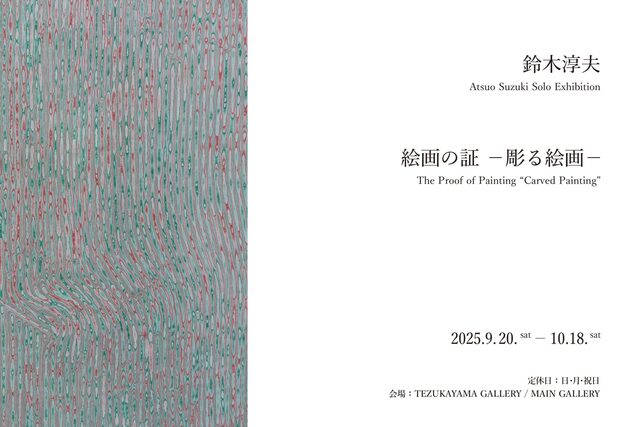
Main Gallery
The Proof of Painting “Carved Painting”
Atsuo Suzuki
2025.9.20 Sat - 2025.10.18 Sat
TEZUKAYAMA GALLERY is pleased to present Atsuo Suzuki’s solo exhibition The Proof of Painting – Carved Painting, opening on September 20.
Born in Aichi Prefecture in 1977, Suzuki completed his graduate studies at Shizuoka University in 2001. He currently lives and works in Toyohashi-city, Aichi, his hometown.
Suzuki refers to his work as “Carved Painting”. By building up multiple layers of paint on wooden panels and then carving into them with a knife, he reveals a variety of motifs and images. This process reflects not only the physical accumulation of paint but also the movements of the artist’s body and the passage of time. Each act of applying paint, every carved mark, and each decision about depth or force is embedded in the surface, simultaneously taxing and embodying the artist’s body while leaving a tangible record of his presence.
These processes result in works of remarkable depth, where physical layers (the built-up paint and the carved surfaces) intersect with the artist’s mental and emotional strata. Acts of “painting,” “layering,” “carving,” and “erasing” reflect the flow of time and the engagement of the body, carrying traces of thought, emotion, and process. The resulting images are not merely visual objects; they resonate as proof of accumulated time, reflections on color, bodily gestures, and the very process of making.
The ongoing series The Proof of Painting, initiated in 2021, embodies Suzuki’s attempt to articulate his vision of painting itself.
We warmly invite you to experience this exhibition.
Artist Statement
Introduction
Since I began exploring “carved painting,” I have continuously asked myself: What is painting? This question deepened in 2003, when I participated in the exhibition “The Proof of Painting,” organized by Gallery Yamaguchi Kunst-Bau. What are the essential elements that constitute a painting? I came to strongly believe that a painting should not merely pursue visual beauty or imagery—it must also be a site where material, the artist’s body, and thought intersect. A painting consists of structural elements such as canvas or panel as its support, along with the paint applied to its surface. But can these alone truly establish a painting? What matters most is the artist’s manual process and thinking that lies between these two components. Applying, scraping, layering, erasing—these repeated gestures leave behind what I call “The proof of painting” on the surface. For example, Yayoi Kusama’s Untitled (No. White A.Z.), which is in the collection of the Shizuoka Prefectural Museum of Art, appears at first glance to be a pale, white surface. Yet, when viewed up close, countless brushstrokes emerge, revealing the artist’s traces of time and physical presence. This sense of “making the invisible visible” left a powerful impression on me.
1. Carved Painting and Optical Mixing
Before I began working as an artist, I explored oil painting and charcoal drawing. I repeated the act of applying and removing paint, feeling a constant sense of frustration with the never-ending process of making—a process that never seemed to reach completion. Even as colors and forms changed through countless revisions, the traces of trial and error remained beneath the surface. I began to search for a way to express this “time” and these “traces” more clearly. That search led me to what I now call “carved painting”. After layering paint onto the surface, I carve into it with a carving knife, allowing the colors underneath to re-emerge. Through this act of removal, past layers of paint are revealed once more. These colors do not physically mix on the surface but are instead optically blended in the viewer’s perception. Moreover, the uneven texture of the carved surface causes the work to shift in appearance depending on the viewer’s angle and the way light enters the space, transforming the painting into something that oscillates between two-dimensional and three-dimensional form. On one occasion, I demonstrated this technique in front of an audience as a kind of performance. I vividly remember an elderly man who watched me silently carving for some time and quietly murmured, “I’m glad I lived to see this.” In that moment, I felt that even an action as simple as carving could allow each viewer to find their meaning.
2. Curating The Proof of Painting
In 2021, I curated The Proof of Painting III – Tokai Version. Rather than continuing to explore painting in isolation, I engaged with other artists, such as Yae Asano, Seiji Kunishima, and Junji Yamada, and encountered their unique techniques and approaches to making art. In 2023, I organized The Proof of Painting IV as a two-person exhibition with Naosuke Wada. Through our collaboration, I reaffirmed the importance of drawing-based methods and thinking. These exhibitions helped me to rediscover the potential of painting itself.
Conclusion
Having gone through these experiences, I have now decided to hold The Proof of Painting as a solo exhibition, to present my view of what painting can be. In particular, this exhibition focuses on color as a central theme. The carved painting technique I have developed over more than two decades has continuously brought me discoveries and challenges. These accumulated experiences have shaped my form of expression. I will continue to seek, with my own hands, the proof of painting—deepening my practice and pushing it further.
Atsuo Suzuki May 14, 2025, At Daan Forest Park